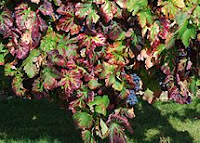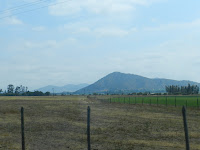He was very proud of its development and history primarily due to
Pablo Morande'

Our tour carriage awaits...
Rarely can the success of a wine valley be put down squarely to the actions of one individual.
But Pablo Morandé´s founding role in the development of wine production in the Casablanca Valley, just over a quarter of a century ago, led the US magazine Wine & Spirits to name the Chilean winemaker the “King of Casablanca”.

Pablo was asked by Chile’s largest wine producer, Concha y Toro, to discover areas suitable for planting grape varieties to produce white wines. Morandé suggested Casablanca valley, which was known for its sandy soils and chilly sea breezes.
But while the directors at Concha y Toro blanched at the idea of investing in an area known for its lack of water and extremes of temperature between night and day, the young winemaker was hooked.
Most of all it was Casablanca’s similarity to wine producing areas in California, including tough grasses, thorny plants and game birds, that convinced Morandé the valley could produce top-quality wines.
"LOOKS LIKE NAPA!" I knew it!
So in 1982, he bought his first 20 hectares and planted vines of Chardonnay, Sauvignon Blanc and Riesling, producing his first wines four years later with encouraging results.
Three years later, Chile’s major wine producers realised that the pioneer was right and moved into the valley. Morandé responded with the creation of his own winery House of Morandé.

The Casablanca Valley is now known for its WHITE WINES...Chardonnay, Sauvignon Blanc, and Rieslings.
The Chileans blend Riesling with Sauvignon Blanc and call it Rhine wine. So when I see Rhine wine in Jumbo in Santiago, I now know what that is....
This is Cuadra's Garden of Grapes....with 26 varieties.
The rest of this post contains pictures of grapes and vines...most all look alike...but have such different qualities that I had to photograph and describe for those of you who yearn to make wine or just enjoy its fruit... This may be boring to some, but not to me!
Wine Regions of Chile -
In Sunday School a long time ago, we read this Proverb... For so long I have searched to plant my own "vineyard."
Epilogue: The Wife of Noble Character
10 [a]A wife of noble character who can find?
She is worth far more than rubies.
11 Her husband has full confidence in her
and lacks nothing of value.
12 She brings him good, not harm,
all the days of her life.
13 She selects wool and flax
and works with eager hands.
14 She is like the merchant ships,
bringing her food from afar.
15 She gets up while it is still night;
she provides food for her family
and portions for her female servants.
16 She considers a field and buys it;
out of her earnings she plants a vineyard.
17 She sets about her work vigorously;
her arms are strong for her tasks.
18 She sees that her trading is profitable,
and her lamp does not go out at night.
19 In her hand she holds the distaff
and grasps the spindle with her fingers.
20 She opens her arms to the poor
and extends her hands to the needy.
21 When it snows, she has no fear for her household;
for all of them are clothed in scarlet.
22 She makes coverings for her bed;
she is clothed in fine linen and purple.
23 Her husband is respected at the city gate,
where he takes his seat among the elders of the land.
24 She makes linen garments and sells them,
and supplies the merchants with sashes.
25 She is clothed with strength and dignity;
she can laugh at the days to come.
26 She speaks with wisdom,
and faithful instruction is on her tongue.
27 She watches over the affairs of her household
and does not eat the bread of idleness.
28 Her children arise and call her blessed;
her husband also, and he praises her:
29 “Many women do noble things,
but you surpass them all.”
30 Charm is deceptive, and beauty is fleeting;
but a woman who fears the LORD is to be praised.
31 Honor her for all that her hands have done,
and let her works bring her praise at the city gate.
AND NOW....to the Grapes (Uvas)...
Carignan - The experts think this grape originated in Aragon, Spain. The grape is often used as a deep coloring component in blends, rather than being made in a varietal form due to its tannins and acidity. It looked like our Texas Mustang Grape...
This is a red black grape...
You can see the color of the carignan grape in the vines...
Carignan is popular in Chile as a blend base. It is also the oldest known grape....
Chasselas - orginally from Egypt. This grape species is over 5000 years old. It is also a primary grape grown in Greece. Many countries claim it as their own, specifically Switzerland...
Pais (Country)- is a red wine grape that has played a prominent role in the Chilean wine industry. Up until the turn of the 21st century, it was Chile's most planted variety until it was overtaken by Cabernet Sauvignon. Today it is most commonly used in the creation of jug wine. MOVE OVER GALLO!
The Somelier told us that Pais was the first grape to come to Chile...with the Spanish Conquistadores. It now the second most planted in order to make "The Blood of Christ" for the church.
Pais grape vines...otherwise known as Mission Grapes.
Mission grapes are a variety introduced from Spain to the western coasts of North and South America in the 16th century for use in making sacramental, table, and fortified wines.
Carménère - THE emblamatic grape of Chile. A member of the Cabernet family of grapes, the name "Carménère" originates from the French word for crimson (carmin), which refers to the brilliant crimson colour of the autumn foliage prior to leaf-fall.
It is almost impossible to find Carménère wines in France today, as phylloxera plague in 1867 nearly destroyed all the vineyards of Europe, afflicting the Carménère grapevines in particular such that for many years the grape was presumed extinct.
Far from being extinct, Carmenere was discovered thriving in Chile, because growers inadvertently preserved the grape variety during the last 150 years, due largely to its similarity to Merlot.
Carménère which, when produced from grapes at optimum ripeness, imparts a cherry-like, fruity flavor with smoky, spicy and earthy notes and a deep crimson color. Its taste might also be reminiscent of dark chocolate, tobacco, and leather. The wine is best to drink while it's young.
It is buttery smooth, but does not possess the robustness of a good Cabernet.
Syrah or Shiraz - is a dark-skinned grape grown throughout the world and used primarily to produce powerful red wines. Syrah should not be confused with Petite Sirah.
It is the world's 7th most grown grape...
Some say this old old grape originated in Shiraz, Iran.... the Phonecians could have brought Syrah/Shiraz to their colony around Marseilles (then known as Massilia), which was founded around 600 BC. 

Aroma characters can range from violets to berries (usually dark as opposed to red), chocolate, espresso and black pepper. No one aroma can be called "typical" though blackberry and pepper are often noticed. With time in the bottle these "primary" notes are moderated and then supplemented with earthy or savory "tertiary" notes such as leather and truffle.
SHIRAZ is my favorite wine.
Today I learned that you can only get the best Shiraz from the coastal estancias....where the soil acidity is higher, which lends the wine to be spicier and lighter than those of Central Chile. When I got back to Parque Arauco, I went straight to El Mundo de Vino and bought two different bottles from the coast. They were expensive, so I am waiting on a special occasion to open them.
Garnacha Tintorea - is a wine grape variety that has been widely cultivated since 1866. The Somelier called it The Micheal Jackson of wine....as it looks red, but squeeze white!
The grape was widely popular in the United States during the years of Prohibition. Grape growers in California's Central Valley found that the grape's pulp was so fleshy and juicy that fermentable juice could be retrieved even after the third pressing. In Chile, they use this grape to blend with Cabernet...
Pull a cork people...enjoy a bottle of Chilean wine.... I will be thinking of you!



























































